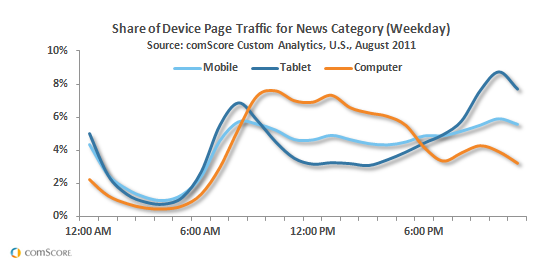comScore has posted some interesting data on the devices people use to consume news:

First off, to be clear, note that the percentages on the left are the percentages of each device’s total use that comes at the time in question. In other words, the scales of each device aren’t directly comparable — there are still far more people using traditional computers than tablets or mobile phones at every hour of the day.
But the time breakdown still matches data from time-shifting apps and elsewhere:
Computers get used during the workday (that big plateau from 9 a.m. to 5 p.m.)
Tablets get used at breakfast, during commutes, on the couch, and in bed (peaks around 8 a.m. and 10 p.m.)
Smartphones get used in spare moments throughout all waking hours.
The newspaper business is putting more emphasis on Sundays in part because they’re one of the few days when people have time to sit back with a newspaper and enjoy the experience. It looks like tablets are moving in to the same sorts of time space.
(It’s also worth thinking about content timing in the context of Pablo Boczkowski’s News at Work, which gets at the ways in which shifting news consumption from the home to the workplace favors certain kinds of content over others.)
More data in comScore’s white paper, downloadable if you give them your name and email.